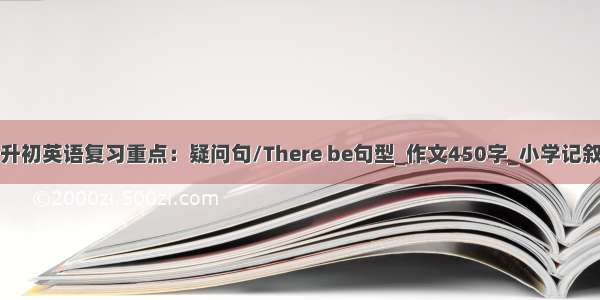
非原创资料,转给小升初家长同学!
人教版PEP教材在小学阶段涉及的重要语法知识主要有7种:
to be句型、
there be句型、
一般现在时句型、
现在进行时句型、
一般过去时句型、
情态动词can引导的型、
be going to句型等。
1) to be句型:用于介绍个人情况如姓名、健康状况、身份、国籍、家庭成员、朋友、
职业等,描述地点、颜色、四季、日期、星期几等,
该句型广泛分布于各册教材中,其中5—8册的句型主要有:
1. Who’s your English teacher?
Mr. Carter.
2. What’s he like?
He’s tall and strong.
3. Is she quiet?
No, she isn’t. She is very active.
4. Is she strict?
Yes, she is, but she’s very kind.
5. What day is it today?
It’s Wednesday.
6. What’s your favourite fruit/food…?
7. They’re sweet/ sour/ salty/ healthy/…
8. When is your birthday?
It’s in May.
9. My birthday is in June. Uncle Bill’s birthday is in June, too.
10. Is her birthday in June?
Yes, it is.
11. What’s the date?
12.This is Zhang Peng.
13. Where is the cinema, please?
It’s next to the hospital.
14. How tall are you?
I’m 164 cm tall.
15. You are shorter than me.
16.You’re 4 cm taller than me.
17.How heavy are you?
I’m 48 kg.
18. I’m thinner than you, and shorter.
19. What’s the matter with you?
My throat is sore.
20. How are you, Liu Yun / Sarah?
2) there be句型:表示存在,即:“某处有某物”或“某时有某事”。句型基本结构为:
There is+ 可数名词单数或不可数名词+时间或地点。
There are+可数名词复数+地点。
该句型主要分布在第5册的Unit 5和Unit 6中,如:
1. There are two bedrooms, a kitchen, a bathroom and a living room.
2. There is a mirror, a bed and a big closet.
3. Is there a forest in the park?
Yes, there is.
4. Is there a river?
No, there isn’t.
5. Are there any pandas in the mountains?
No, there aren’t.
6. Are there any fish in the rivers?
Yes, there are.
3) 一般现在时句型:表示习惯性的动作或行为,或现在存在着的状况。
句型基本结构为:主语+行为动词+其他。
当主语是第三人称单数时,要在动词原形后面加s或es,其他人称作主语时则用动词原形,在问句及否定句中需要用助动词do或does。
这种句型通常有一些标志词,如:usually often sometimes never always等。
该句型主要分布在第5册Unit2&3,第6册Unit1&2, 第7册Unit4,5,6, 第8册Unit2中。
1. What do you have on Thursdays?
We have English, math and science on Thursdays.
2. What do you do on Saturdays?
I watch TV on Saturdays.
3. I do my homework.
4. What do you have for lunch on Mondays?
We have tomatoes, tofu and fish.
5. I like fruit. But I don’t like grapes.
Book6:
1. When do you eat dinner?
I eat dinner at 7:00 in the evening.
2. When do you get up?
I usually get up at 12:00 noon.
3. What do you do on the weekend?
Usually I watch TV and go shopping.
4. Sometimes I visit my grandparents.
I often play football. Sometimes I go hiking.
5. Which season do you like best?
I like winter best.
6. Why do you like summer/winter?
Book7:
1. How do you go to school, Sarah?
2. Usually I go to school on foot.
Sometimes I go by bike.
3. I like collecting stamps.
He likes collecting stamps, too.
4. Does she teach math?
Yes, she does.
5. Does she teach English?
No, she doesn’t. She teaches math.
6. What does your mother do?
What does your father do?
7. Where does she work?
She works in a car company.
8. How does she go to work?
She goes to work by bus.
9. Where does the rain come from?
It comes from the clouds.
10. Where does the cloud come from?
It comes from the vapour.
11. Where does the vapour come from?
It comes from the water in the river.
12. The sun shines and the water becomes vapour.
13. How do you do that?
Book8:
1. My nose hurts.
2. How do you feel?
I feel sick.
How does Amy feel?
3. You look so happy.
You look sad today.
4) 现在进行时句型:表示说话时正在进行的动作或事件,或在短期内正在进行的
动作或存在的情况。
标志词是:now 也常用在Look! Listen!等后面。
句型主要结构为:be动词(am, is, are)+动词现在分词(v. ing)。
该句型主要分布在第6册Unit4, 5, 6中。如:
1. What are you doing?
I’m doing the dishes. I’m reading a book.
2. Grandpa is writing a letter.
Brother is doing homework.
Mom is cooking dinner in the kitchen.
3. He is writing an e-mail in the study.
4. What is it doing ?
It’s eating bananas.
5. What is she doing ?
She’s jumping.
6. What are they doing ?
They’re swimming.They’ re climbing trees.
7. Are you eating lunch?
No, we aren’t.
8. Are they eating the honey?
Yes, they are.
9. Is he playing chess?
Yes, he is.
10. Is she counting insects?
No, she isn .
5) 一般过去时句型:表示过去发生的而现在已经结束的事件、动作或情况。
句型基本结构为:主语+动词过去式+其他。
标志词通常是:yesterday, last week , last year 等,在问句与否定句中用助动词did。
该句型分布在第8册Unit3&4中。如:
1. What did you do last weekend?
I played football.
2. Did you help them clean their room?
Yes, I did.
3. What did you do yesterday?
I went fishing.
4. Did you read book?
Yes, I did.
5. Did you clean your room?
No, I didn’t.
6. Where did you go on your holiday?
I went to Xinjiang.
7. What did you do there?
I sang and danced with my new friends.
8. How did you go there?
I went by train.
此外,一般过去时也可用来表示客气的询问。如:
Book3 Unit5, Book 5 Unit3中的:
What would you like for lunch?
Id like some…
6) 情态动词can引导的句型:表示有能力做某事,can后面的动词要用原形。
该句型主要分布在第5册Unit4和第7册Unit1中。如:Book4:
1. What can you do?
I can sweep the floor.
I can cook the meals.
2. I can water the flowers.
3. Can you make the bed?
No, I can’t.
4. Can you use a computer?
Yes, I can.
Book7: How can I get to Zhongshan Park?
You can go by the No. 15 bus.
7) 将来时:我们的教材中出现过两种表示将来时的句型:
will和be going to句型,主要以be going to句型为主,将要做某事或打算做某事。
句型主要结构:am/is/are + going to + v.原形。
标志词有:tomorrow next weekend this morning this weekend next…be going to
Book7:
1. What are you going to do this weekend?I am going to visit my grandparents.
2. Where are you going? I am going to the cinema.
3. How is he going to Beijing? He is going to Beijing by plane.
4. When is she going to Xiashan? She is going to go there at 9:00 am
学生易错考点
1.a, an的选择: 元音开头的单词用an,辅音开头的单词用a.
2.am, is, are的选择: 单数用is, 复数用are. I 用 am , you 用 are.
3.have, has 的选择: 表示某人有某物。单数用has, 复数用have. I, you 用 have.
4.there is, there are 的选择:表示某地有某物,某人。单数用there is, 复数用there are.
5.疑问词的选择:what (什么) who (谁) where (哪里) whose (谁的) why(为什么)
when(什么时候)which(哪一个)
how old (多大) how many (多少)how much(多少钱)
6. 现在时、过去时、将来时、现在进行时的各种特殊疑问句及回答
7. 形容词比较级
当我们需要对两个事物或人作出比较时,需要用到比较级。比较级的句子结构通常是:
什么人或物 + 动词be (am , is , are ) + 形容词的比较级 + than(比)+ 比较对象
I’m taller and heavier than you. (我比你更高和更重。)
An elephant is bigger than a tiger. (一只大象比一只老虎更大。)
形容词的比较级是在形容词的基础上变化而来的,它的变化规则是:
① 一般的直接在词尾加er ,如 tall - taller, strong - stronger ,
② 以e结尾的,直接加r ,如 fine – finer,
③ 以辅音字母加y结尾的,先改y为i再加e,如funny - funnier
④ 双写最后的字母再加er,如big – bigger, thin – thinner, hot – hotter
☆注意比较的两者应该是互相对应的可比较的东西。
8. 动词过去式详解动词的过去式的构成规则有:
A、规则动词
① 一般直接在动词的后面加ed:如worked, learned, cleaned, visited
②以e结尾的动词直接加d:如lived, danced, used
③以辅音字母加y结尾的动词要改y为i再加ed(此类动词较少)如
study – studied, carry – carried, worry – worried (注意play、stay不是辅音字母加y)
④ 双写最后一个字母(此类动词较少)如stopped
B、不规则动词(此类词并无规则,须熟记)小学阶段要记住以下动词的原形和过去式:
sing – sang, eat – ate, see – saw, have – had, do – did, go – went, take – took,
buy – bought, get – got, read – read, fly – flew, am/is – was, are – were, say – said,
leave – left, swim – swam, tell – told, draw – drew, come – came, lose – lost,
find – found, drink – drank, hurt – hurt, feel – felt
9. 动词现在分词详解动词的ing形式的构成规则:
① 一般的直接在后面加上ing, 如doing, going, working, singing, eating
② 以e 结尾的动词,要先去e再加ing,如having, writing
③ 双写最后一个字母的(此类动词极少)有:running, swimming, sitting, getting
图片选自网络,版权为原作者所有!
















